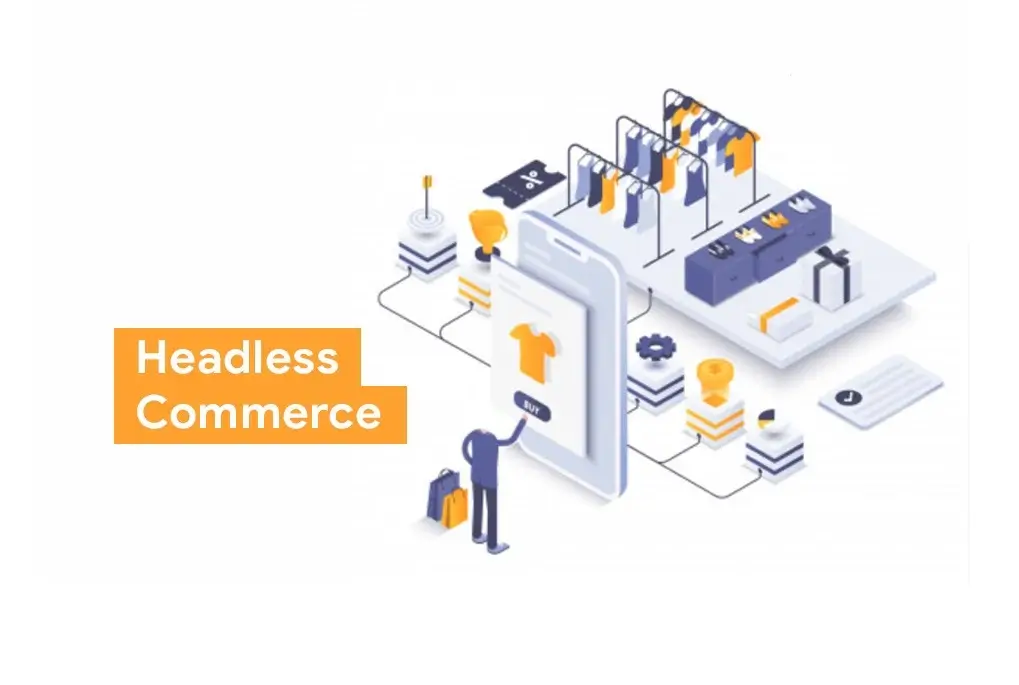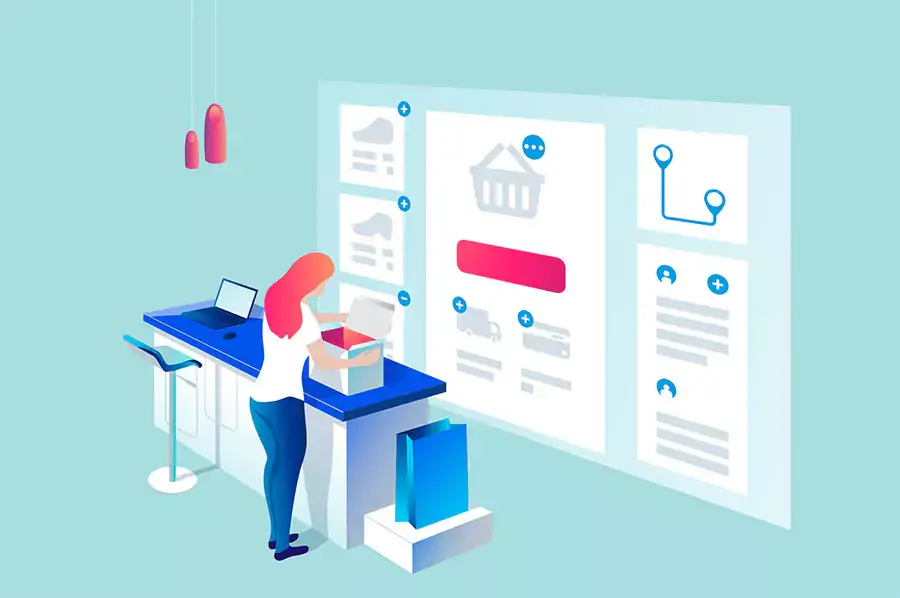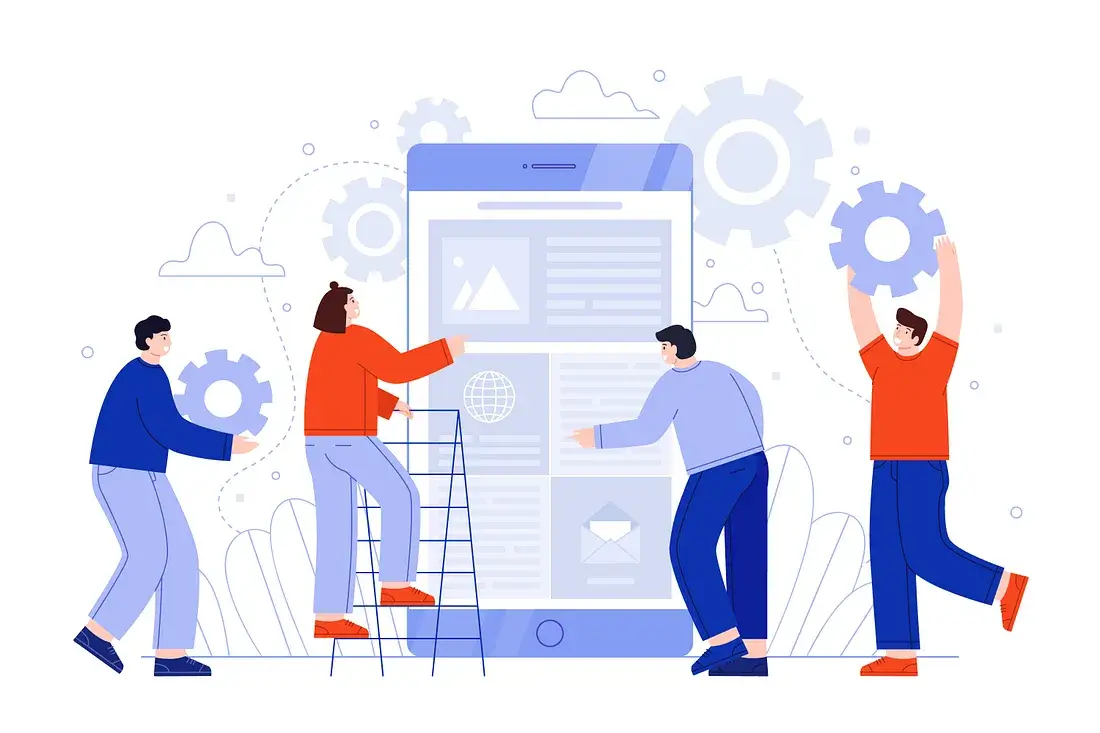eCommerce businesses today have two primary options for their technology architecture: traditional and headless. These two structures have distinct architectures and functionalities, and your organization’s specific objectives, capabilities, and resources will determine which model is best. In this article, we will provide a thorough comparison of Headless Commerce vs Traditional Commerce, as well as guidance on when and how to choose each. By understanding these key distinctions, you will be able to make an informed decision regarding the best eCommerce platform for the growth of your business.
Table of Contents
Headless Commerce vs Traditional Commerce: Overview
What is Headless Commerce
Headless Commerce is an innovative approach to eCommerce architecture that decouples the front-end and back-end systems of an online store. As described in the name, the decoupled structure of Headless Commerce refers to the separation of the head, where the content is presented, from the body, where the content is stored and managed. This enables businesses to implement independent updates or modifications to the presentation layer while preserving a single source of content and data in the backend.

The key to the flexibility of Headless Commerce is API. The API technology allows the connection between the front-end and back-end, acting as a bridge for data exchange and functionality access. This frees developers from having to rely on a single technology or programming language to create applications, while companies can create highly customized and engaging user interfaces, such as websites, mobile apps, or even voice-activated shopping experiences.
This flexibility empowers organizations to stay agile, rapidly innovate, and deliver seamless shopping experiences across various channels, ultimately enhancing their ability to meet the evolving needs and preferences of today’s consumers. With its ability to reach a wider variety of customers across a larger platform base, Headless Commerce has become an important tool for any eCommerce businesses. It represents a fundamental shift in the way businesses approach online retail, offering greater adaptability and scalability in an increasingly competitive digital marketplace.
What is Traditional Commerce
Traditional Commerce refers to the conventional way of doing online retail, operating under an all-in-one platform that bundles the front-end user interface with the back-end infrastructure and database. This architecture is diametrically opposed to that of Headless, which employs a decoupled design.
In this monolithic architecture, the front-end code containing site templates and design is tightly coupled with the back-end code that handles checkout, payment processing, inventory management, and other fundamental functions. Typically, this unified software solution handles every aspect of the online store.
Traditional Commerce platforms often provide pre-designed templates and a fixed structure for the online store’s appearance and functionality. This enables back-end simplicity and offers convenience in finding the right templates for your stores. However, the tradeoff is that brands face limitations in customization options, making it harder to adapt to changing market demands.

Traditional Commerce has been the dominant model for many years. However, at the peak of the digital era, customers have shifted their shopping preferences to online platforms in more diverse ways, thus this monolithic architecture may struggle to keep pace with the rapidly evolving digital landscape. Businesses operating in this framework often face challenges when trying to implement new technologies, create unique user experiences, or seamlessly integrate with emerging sales channels, such as mobile apps or voice commerce platforms, as they are constrained by the limitations of their integrated systems.
Headless Commerce vs Traditional Commerce: What are the differences?
Front-end development
The notable distinction between these systems is that Headless offers ultimate front-end flexibility while Traditional locks you into the platform’s back-end infrastructure. The decoupled architecture of Headless Commerce allows for greater flexibility in front-end development. Developers have the freedom to use modern technologies, frameworks, and design principles to create unique and tailored user interfaces that align with their brand and customer preferences.
However, this leads to a tradeoff. While you are free to customize your storefronts, you must either build your own back-end from scratch or integrate various services, increasing the complexity and costs you have to pay. This can definitely be mitigated when it comes to Traditional Commerce, as this platform provides a pre-built, unified back-end system, although you’ll have to deal with limitation in front-end innovation.
User experience
These platforms offer different user experiences due to their distinct structures. In Traditional Commerce, the user experience is frequently constrained by the limitations of integrated platforms. Although it may be easier for businesses to manage orders when customers complete the entire shopping process on a single platform, it can result in a less responsive shopping experience for customers because they are not always on your websites.
In contrast, Headless Commerce excels at providing a superior user experience. With the ability to independently design and optimize front-end experiences, businesses can create highly customized and streamlined shopping journeys. This personalization may include responsive designs for a variety of devices, streamlined navigation, faster page loading times, and intuitive user interfaces, ultimately boosting customer satisfaction and conversion rates.
Flexibility & personalization
The decoupled structure of Headless Commerce definitely results in unparalleled flexibility and personalization compared to Traditional Commerce. Headless Commerce empowers businesses to tailor their online stores to specific customer segments, experiment with new features and rapidly implement changes without disrupting the entire eCommerce ecosystem. However, this practice requires significant upfront development and integration work.

Traditional Commerce, may not be able to provide such great flexibility. However, by operating on a single eCommerce platform only, Traditional Commerce is able to put greater focus on consistency, potentially compromising unified experience and personalization for customers. This is also a less complex and cheaper method.
Third-party integration
Headless Commerce shines in terms of third-party integration capabilities. Traditional Commerce platforms may have limitations when it comes to integrating with external services, such as marketing automation tools, CRM systems, or emerging technologies. In contrast, Headless Commerce can seamlessly integrate with a wide range of third-party applications and services through APIs (Application Programming Interfaces). This extensibility allows businesses to leverage best-of-breed solutions for various aspects of their eCommerce operations, from marketing and analytics to payment processing and shipping, enhancing their overall efficiency and competitiveness.
Platform complexity
Another key distinction between Headless Commerce vs Traditional Commerce is the complexity of the platform. The idea of building a unique front-end for each presentation layer of Headless Commerce can be interesting, however, creating the whole back-end system from scratch is a daunting task. It requires expertise in frontend frameworks, backend systems, and API development. The resulting sites also need maintenance efforts as well as specialized resources. Moreover, the modularity of the Headless Commerce platform can introduce additional complexity beyond what you are already familiar with.
Traditional Commerce on the other hand, with built-in features and monolithic architectures, requires less effort in development and maintenance. It is easy to set up and can be launched quickly, making it a much less resource-intensive system when compared to Headless Commerce.
Headless Commerce vs Traditional Commerce: Which one wins the battle? Pros and cons of each approach
Headless Commerce pros
Faster time to market
The first and foremost benefit of Headless Commerce is that it can facilitate a faster time to market. The decoupled architecture enables rapid development and experimentation of new features, updates, and user experiences. Developers are free to experiment with any new technology or framework without concern for the back-end. This expedites time to market, which is crucial in the fast-paced eCommerce environment and with the constant changes in customer demand. Consequently, your businesses can maintain a competitive advantage, respond rapidly to shifting customer preferences, and capitalize on emerging trends.
Complete control over the platform
With Headless, brands have complete control over the front-end code base’s visual design and layout. This enables pixel-perfect customization in accordance with branding requirements, unrestricted by premade templates. Rather than being limited to a single solution, businesses are free to select the most appropriate tools and technologies for their unique requirements. This control extends to the design, user experience, and functionality, enabling a brand identity and customer journey that precisely aligns with business objectives.
Increased personalization
With complete control over the presentation layer, Headless Commerce enables businesses to provide highly customized customer experiences. You can create individualized UX/UI design, content, and product recommendations for each customer to accommodate their unique preferences and behaviors. This level of personalization increases customer engagement, boosts conversion rates, and fosters customer loyalty, ultimately leading to increased revenue and customer retention.
Flexibility and scalability
Headless Commerce brings great flexibility and scalability, making continuous improvement easier. Your businesses can roll out new features and innovations in a progressive, agile way rather than a monolithic structure. Integration with third-party services and software is able to be accomplished seamlessly. This increases the adaptability of your businesses, which is essentially important in the ever-changing market conditions.

Flexible integration also enables your businesses to expand the functionalities of your websites. Added features or systems such as order management, CRM, ERP, or inventory management, among others, will be a great deal when it comes to increasing the operational effectiveness of your eCommerce businesses. This scalability ensures that your eCommerce platform grows with your businesses, whether it’s expanding product offerings, entering new markets, or handling increased traffic during peak seasons.
Headless Commerce cons
Complex development and implementation
The main downside of Headless Commerce is greater complexity upfront. Brands must build and connect the front-end and back-end systems, which requires advanced web development skills. Integrating various components and ensuring seamless communication between the front-end and back-end is surely not an easy task. Therefore, your businesses will definitely need skilled developers who are well-served in modern technologies and API. Businesses who don’t own these skills in-house may have to hire an additional support team, which may cost an additional budget.
High upfront costs
As a highly complex system, Headless Commerce involves significantly higher upfront costs compared to traditional platforms. Businesses need to invest in custom development, API integration, and specialized front-end and back-end tools.
These initial expenses may deter smaller companies with limited budgets. However, the long-term benefits, such as increased revenue and agility, often justify the initial investment for larger enterprises and those committed to delivering exceptional online shopping experiences. Therefore, it is essential for businesses to understand Headless Commerce pricing to effectively manage your budget.
Challenging ongoing maintenance
While Headless Commerce offers flexibility and control, it also comes with the responsibility of ongoing maintenance. Managing multiple components and ensuring they work harmoniously is a challenging task. Moreover, as new technologies and updates emerge, maintaining compatibility and security across the platform also requires continuous effort and resources.
Consequently, you must be prepared for the ongoing maintenance demands. Make frequent auditing to identify any problems that may occur and consider how to address them effectively. This can help you to ensure the long-term success of your Headless Commerce setup.
Traditional Commerce pros
Ease-of-use
Traditional software was designed for a single deliverable: an integrated, tightly coupled system that is relatively simple to deploy and test. Therefore, it comes with a user-friendliness design in mind.
Traditional Commerce platforms offer intuitive interfaces, drag-and-drop features, and pre-designed templates that make it relatively easy for businesses to set up and launch their online stores. This simplicity is especially beneficial for small to medium-sized enterprises that do not have extensive technical expertise or resources for complex development.
Integrated CMS
Many Traditional Commerce platforms come with built-in content management systems, allowing businesses to manage both their product catalog and website content from a single interface. This integration simplifies content updates, making it convenient for businesses to maintain product listings, blogs, and other informational content.
Along with its easy-to-use feature, you can easily make changes to your content and provide updated information and news about your products to your customers. If your businesses own large product categories, Traditional Commerce would be ideal for effective content management, where quick updates for your products are made easy.
Launch store quickly
Traditional Commerce typically includes various front-end templates, which are equivalent to pre-built storefronts. You only need to choose a template that aligns with your brand identity and showcases your product offerings, and then make any necessary modifications, such as adding product images, content, brand colors, and site copy. Combined with the user-friendly functionalities, you can have your eCommerce site up and running within a few hours without any complex technical skills or effort.
Traditional Commerce cons
Limited flexibility options
The monolithic structure of Traditional Commerce might be convenient and easy-to-use. However, when change is inevitable and imminent, critical and frequent updates are crucial, and the tightly bound front and back ends of a monolith commerce platform hamper a business’s ability to catch up with the rapid change.

Businesses’ flexibility in terms of customization is limited with Traditional Commerce. They are restricted to the platform’s predefined templates and features, making it difficult to establish a distinct online presence. This lack of flexibility can be a significant disadvantage if your businesses are seeking to differentiate yourselves in a competitive market or to innovate user experiences.
Difficult to customize user experience
With limited flexibility options, customizing the user experience on Traditional Commerce platforms is considerably challenging and may require advanced technical skills. Making changes beyond simple design modifications can be time-consuming and costly. This hinders businesses from implementing tailored features, personalized recommendations, or advanced functionality, which are essential factors in enhancing the overall shopping experience and driving higher conversion rates.
Depending on the platform provider
Companies that use Traditional Commerce platforms are highly dependent on the platform provider for support, updates, and security measures. You may run into problems with compatibility, security vulnerabilities, or difficulties in transitioning to a new solution if the provider decides to stop supporting a particular platform or fails to keep it updated. This dependence on a third-party provider limits your company’s control over your online presence and long-term sustainability.
What should you choose? Headless Commerce vs Traditional Commerce?
Consider your business sizes, needs, and goals
Choosing between Headless Commerce vs Traditional Commerce should begin with a careful evaluation of your business’s size, needs, and goals. For example, smaller businesses with limited budgets and technical resources may find Traditional Commerce platforms more accessible and cost-effective. They can receive out-of-the-box solutions that are easier to set up and manage.
On the other hand, larger enterprises with ambitious growth objectives and a need for highly customized user experiences may find Headless Commerce more beneficial. They can utilize the decoupled structure of Headless Commerce to facilitate their omnichannel strategy, increase their online coverage, and enhance customer engagement. These all contribute to building a competitive advantage, as well as boosting conversion rates.
There is no answer to the question of which platform is the best. Assess your scalability requirements, desired level of personalization, and how crucial it is for your brand to stand out in a competitive market. Understanding your business context will help you make an informed choice to make the most out of your investment in any eCommerce system.
Assess technical capabilities
The technical capabilities of your organization play an important role in the decision-making process when it comes to choosing between Headless Commerce vs Traditional Commerce. Traditional Commerce platforms are typically simpler to implement and maintain, making them suitable for organizations with limited development expertise. However, if your team has skilled developers or is willing to invest in external expertise, Headless Commerce can provide greater flexibility and potential for innovation.

Consider your technical expertise as well as your adaptability to new technologies and workflows. Additionally, consider how you intend to manage integrations with third-party tools, as Headless Commerce provides greater control in this regard but may require additional technical expertise to manage effectively.
Weigh the total cost of ownership
Both Headless and Traditional Commerce solutions come with associated costs, and it’s essential to weigh the total cost of ownership (TCO) over the long term. Smaller businesses with limited budgets may benefit from the lower up-front costs and lower ongoing maintenance requirements of Traditional Commerce platforms. However, Headless Commerce may yield a greater ROI over time, especially for larger businesses that require extensive customization, scalability, multichannel presence, and a unique user experience.
Consequently, you must evaluate the initial development costs, ongoing maintenance expenses, and potential revenue gains of each option. Take into account your company’s financial resources in this evaluation. Consider the scalability and growth potential of your chosen solution, as well as how it aligns with your organization’s financial goals and generates long-term business benefits.
Wrapping up
The dichotomy between Headless Commerce and Traditional Commerce reflects the ongoing transformation of the retail landscape. Although Traditional structure still holds a significant position in the industry, digital innovation and changing consumer experiences have facilitated the need for the establishment of Headless architecture.
Through this article, we hope to provide a thorough comparison between Headless Commerce vs Traditional Commerce, highlighting their key differences. There is no definitive answer to the question of which application platform is the best. Each encounters its own individual advantages and values. The decision regarding the optimal platform is dependent on your unique business context and priorities.
In addition, if you require additional assistance deciding between Headless Commerce vs Traditional Commerce, our certified consulting team will be available around-the-clock to assist you. We will provide a detailed evaluation of your business’s current situation, thus suggesting the best solutions for you to thrive in your digital journey.











